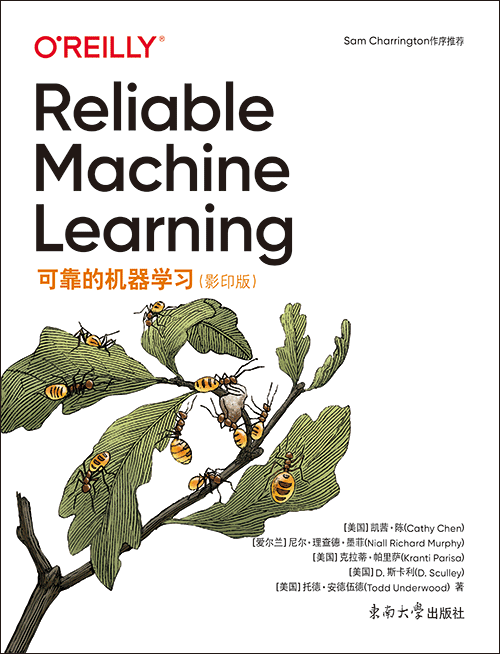可靠的机器学习(影印版)
出版时间:2023年03月
页数:376
“在将基于机器学习的真实系统投入部署之前,你便能从阅读本书中受益。放心吧,书中的内容来自数十年间来之不易的经验。”
——Andrew Moore
Google Cloud AI副总裁兼总经理
无论你是小型创业公司还是跨国公司的一员,这本实践用书都为你(数据科学家、软件和网站可靠性工程师、产品经理或企业主)展示了如何在组织内可靠、有效和负责地运行和建立机器学习。你将深入了解其中涉及的方方面面,从如何在生产中进行模型监控到如何在产品组织中运营一个完善的模型开发团队。
通过将SRE思维应用于机器学习,作为本书作者和工程专业人士的Cathy Chen、Kranti Parisa、Niall Richard Murphy、D. Sculley、Todd Underwood以及特邀作者向你展示了如何运行高效可靠的机器学习系统。无论你是想增加收入、优化决策、解决问题,还是想理解和影响客户行为,你都将学到如何执行日常的机器学习任务,同时保持更广阔的视野。
本书内容包括:
● 什么是ML:运作方式以及依赖什么
● 用于理解机器学习“环路”如何工作的概念框架
● 有效的生产如何使机器学习系统易于监控、部署和操作
● 为什么机器学习系统使生产故障排除更加困难,以及如何进行相应的补偿
● 机器学习、产品和生产团队如何有效沟通
——Andrew Moore
Google Cloud AI副总裁兼总经理
无论你是小型创业公司还是跨国公司的一员,这本实践用书都为你(数据科学家、软件和网站可靠性工程师、产品经理或企业主)展示了如何在组织内可靠、有效和负责地运行和建立机器学习。你将深入了解其中涉及的方方面面,从如何在生产中进行模型监控到如何在产品组织中运营一个完善的模型开发团队。
通过将SRE思维应用于机器学习,作为本书作者和工程专业人士的Cathy Chen、Kranti Parisa、Niall Richard Murphy、D. Sculley、Todd Underwood以及特邀作者向你展示了如何运行高效可靠的机器学习系统。无论你是想增加收入、优化决策、解决问题,还是想理解和影响客户行为,你都将学到如何执行日常的机器学习任务,同时保持更广阔的视野。
本书内容包括:
● 什么是ML:运作方式以及依赖什么
● 用于理解机器学习“环路”如何工作的概念框架
● 有效的生产如何使机器学习系统易于监控、部署和操作
● 为什么机器学习系统使生产故障排除更加困难,以及如何进行相应的补偿
● 机器学习、产品和生产团队如何有效沟通
- Foreword
- Preface
- 1. Introduction
- The ML Lifecycle
- Lessons from the Loop
- 2. Data Management Principles
- Data as Liability
- The Data Sensitivity of ML Pipelines
- Phases of Data
- Data Reliability
- Data Integrity
- Conclusion
- 3. Basic Introduction to Models
- What Is a Model?
- A Basic Model Creation Workflow
- Model Architecture Versus Model Definition Versus Trained Model
- Where Are the Vulnerabilities?
- Infrastructure and Pipelines
- A Set of Useful Questions to Ask About Any Model
- An Example ML System
- Conclusion
- 4. Feature and Training Data
- Features
- Labels
- Human-Generated Labels
- Metadata
- Data Privacy and Fairness
- Conclusion
- 5. Evaluating Model Validity and Quality
- Evaluating Model Validity
- Evaluating Model Quality
- Operationalizing Verification and Evaluation
- Conclusion
- 6. Fairness, Privacy, and Ethical ML Systems
- Fairness (a.k.a. Fighting Bias)
- Privacy
- Responsible AI
- Responsible AI Along the ML Pipeline
- Conclusion
- 7. Training Systems
- Requirements
- Basic Training System Implementation
- General Reliability Principles
- Common Training Reliability Problems
- Structural Reliability
- Conclusion
- 8. Serving
- Key Questions for Model Serving
- Model Serving Architectures
- Model API Design
- Serving for Accuracy or Resilience?
- Scaling
- Disaster Recovery
- Ethics and Fairness Considerations
- Conclusion
- 9. Monitoring and Observability for Models
- What Is Production Monitoring and Why Do It?
- Problems with ML Production Monitoring
- Best Practices for ML Model Monitoring
- Conclusion
- 10. Continuous ML
- Anatomy of a Continuous ML System
- Observations About Continuous ML Systems
- Continuous Organizations
- Rethinking Noncontinuous ML Systems
- Conclusion
- 11. Incident Response
- Incident Management Basics
- Anatomy of an ML-Centric Outage
- Terminology Reminder: Model
- Story Time
- ML Incident Management Principles
- Special Topics
- Conclusion
- 12. How Product and ML Interact
- Different Types of Products
- Agile ML?
- ML Product Development Phases
- Build Versus Buy
- Sample YarnIt Store Features Powered by ML
- Conclusion
- 13. Integrating ML into Your Organization
- Chapter Assumptions
- Significant Organizational Risks
- Implementation Models
- Organizational Design and Incentives
- Conclusion
- 14. Practical ML Org Implementation Examples
- Scenario 1: A New Centralized ML Team
- Scenario 2: Decentralized ML Infrastructure and Expertise
- Scenario 3: Hybrid with Centralized Infrastructure/Decentralized Modeling
- Conclusion
- 15. Case Studies: MLOps in Practice
- 1. Accommodating Privacy and Data Retention Policies in ML Pipelines
- 2. Continuous ML Model Impacting Traffic
- 3. Steel Inspection
- 4. NLP MLOps: Profiling and Staging Load Test
- 5. Ad Click Prediction: Databases Versus Reality
- 6. Testing and Measuring Dependencies in ML Workflow
- Index
书名:可靠的机器学习(影印版)
国内出版社:东南大学出版社
出版时间:2023年03月
页数:376
书号:978-7-5766-0552-5
原版书书名:Reliable Machine Learning
原版书出版商:O'Reilly Media
The insect on the cover of Reliable Machine Learning is the honeypot ant (Myrmecocystus mimicus). Honeypot ants are found in southwest North America and parts of Mexico.
Similar to other ants, honeypot ant colonies consist of a variety of worker ants who scavenge food from flowers, fruit, and other insects. What is most notable about honeypot ants is how they store food. The repletes—one type of worker ant in the colony—grow large abdomens that they use to store the liquid they scavenge. During times when food supply is low, the repletes regurgitate liquid for the rest of the colony to eat. Repletes have a hard time moving around because of the size of their abdomen, so they are often found hanging from the roof of their nest.
Similar to other ants, honeypot ant colonies consist of a variety of worker ants who scavenge food from flowers, fruit, and other insects. What is most notable about honeypot ants is how they store food. The repletes—one type of worker ant in the colony—grow large abdomens that they use to store the liquid they scavenge. During times when food supply is low, the repletes regurgitate liquid for the rest of the colony to eat. Repletes have a hard time moving around because of the size of their abdomen, so they are often found hanging from the roof of their nest.
购买选项
